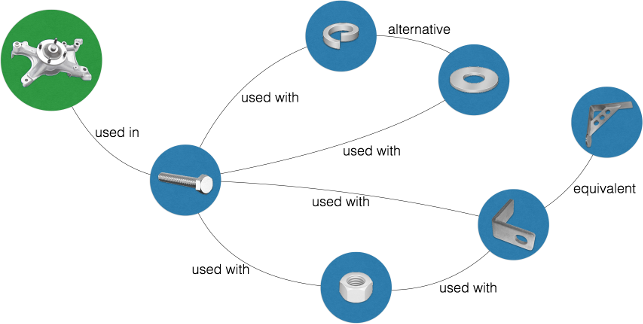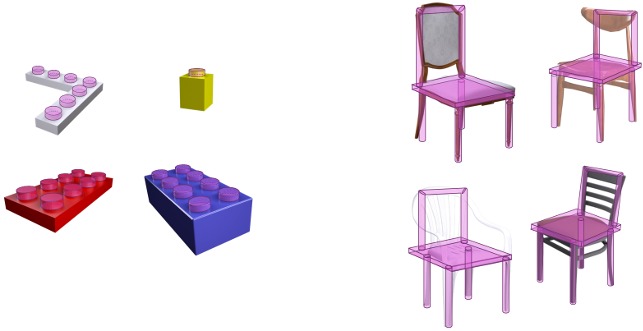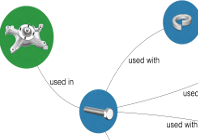
Design Graph will be part of Autodesk’s A360 cloud-based design and collaboration platform later this year
Any designer who’s ever worked at a large firm most likely knows the frustration of looking for a design file for a standard component and coming up empty handed.
A gear for a bicycle, for instance, has certainly been designed and used before. The question is: where’s the file? You’ve searched, using all the obvious terms, but it’s not there. So what do you do? You design it again.
You’re not alone. It turns out this is a common problem. “One customer we talked to had 899 versions of the same part,” says Mike Haley, Senior Director of Emerging Products and Technologies at Autodesk. “Not 899 digital copies of the same design – it had actually been designed 899 different times over many years.”
Not only is all that duplicated work expensive, it can also create problems in production. What if the new gear design turns out to be off by a millimetre? An error like that can mean weeks of unplanned retooling in the factory if it isn’t caught in time.
The root problem? Organising design data is a significant challenge, according to Haley. “After all, design data is inherently graphical. It’s not text. And it’s hard to search for something that’s not text.”
So how should you organise it? Haley and his team at Autodesk are working on a solution. Over the past four years, they’ve used machine learning to create a system that can categorise design data without human assistance and build design taxonomies, so when you need a certain design, you can find it.
The product, called Design Graph, will become available to the public for the first time later this year as part of Autodesk’s A360 cloud-based design and collaboration platform.
Haley shared his thoughts on the system with product designers as part of Autodesk University 2015 in Las Vegas, explaining how it has the potential to save time in the design process, decrease redundant work, and reduce costly errors.
Eventually, it may even enable computers to do some elementary design tasks for us.
Machines that learn on their own
Machine learning is a branch of computer science that uses algorithms to enable computers to learn independently, identify patterns, and make predictions based on what it learns.
It’s used in tasks like spam filtering, optical character recognition (OCR), and automatically recognising faces in your photo album – anywhere you want computers to identify the common traits of objects as well as to discern the subtle variations in them and the contexts in which they appear.
In the case of design data, the goal has been to teach computers to be able to identify and understand designs based on their inherent characteristics – their shape and geometry – rather than by any labelling or metadata.
After all, whoever designed the part originally could label it any of dozens of ways, using full words or abbreviations. Metadata created by people, unless carefully managed, is simply unreliable.
Instead, the computer uses its own observations about the 3D mesh, which every 3D model has by definition.

When you look at Lego bricks, your brain knows almost instantly what they are – the same is true of chairs, but for different reasons
Shape vs. features?
Programmers have been trying to create a system like this for more than a decade. But it turns out that it’s harder than it looks, according to Haley. Why? Because there are two primary ways that we organise visual data: by feature, and by morphology or shape.
Haley gives the contrasting examples of Lego building blocks and chairs. “When you look at Lego bricks, your brain knows almost instantly what they are, despite the fact that they may be all kinds of shapes and colors,” he says.
“You don’t care about the variation. Your eyes hone in on the little studs. Those studs are the features that are more important than the shape of the bricks.”
A group of different chairs, on the other hand, is the opposite. In that case, they have different features – some have armrests, some don’t, some have padding, some don’t – “but your brain knows that they’re chairs,” says Haley. “Your brain picks up on their morphology.”
“So you have two completely opposite approaches to shape,” he goes on. “This is a very human thing. It’s how we relate to those objects and how we use them.”
With Design Graph, developers had to figure out the balance of these two approaches – feature-led and morphology-led – using different algorithms that work in tandem, depending on context.
Design Graph in action
The result is a mind-blowingly complex graph, in which each node represents a design or a component within a design, and the lines connecting them represent the relationships between them.
Using the Design Graph, however, is relatively simple.
Say that you’re designing that bicycle, for example, and you need a certain gear. If you’re working in A360, you’ll be able to switch to Design Graph and search based on name, shape, category, properties – or a combination of these – to find the right pre-existing gear design from your own firm.
While the system uses the millions of designs stored in the cloud to learn, it only serves up designs that you have privileges to access. Identical designs will appear as a single object, while slight variations will appear as separate designs, and you’ll be able to see how frequently each was used.
Once you find what you’re looking for, you just drop it into your design – no hunting through the catalogue.
Eventually, Design Graph will go one step further, and begin to suggest parts based on what you’re designing.
“For example, if it sees that you’re designing something with a bolt and a plate, it might suggest a nut and a washer, since those are frequently used together,” says Haley.
Haley’s hope is that Design Graph will enable designers to focus more on the design problem itself, rather than the mechanics of representing the design.
Coming soon
Haley expects Design Graph to debut in A360 sometime this year, although the date hasn’t yet been set. A360 is Autodesk’s cloud-based design and collaboration platform which enables teams to work together on 3D designs from anywhere.
au.autodesk.com
To learn more about Design Graph and see it in action, you can watch Haley’s class from Autodesk University 2015 in Las Vegas click here. To learn more about the A360 platform, you can watch a class by software architect Alex Chien click here

Finding files you’ve used before could become easier with Design Graph
[sponsored content]
Default







Pingback: Beyond PLM (Product Lifecycle Management) Blog Will machine learning eliminate part numbers? - Beyond PLM (Product Lifecycle Management) Blog